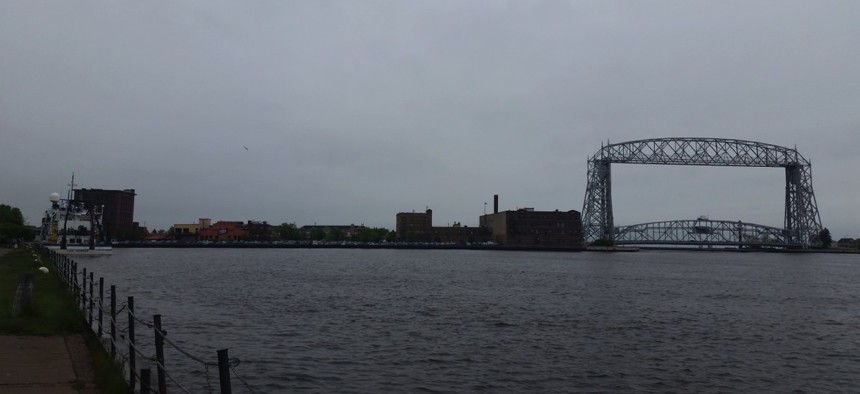Route Fifty Roadmap: An Iconic Piece of Infrastructure for the Zenith City

The Aerial Lift Bridge in Duluth, Minnesota. Dave Nyczepir / Route Fifty
The 111-year-old Aerial Lift Bridge is a reminder of Duluth’s industrial past and a landmark that’s at the center of the city’s tourism efforts.
Route Fifty Roadmap is an ongoing series of dispatches from the semi-regular travels of the Route Fifty staff around the United States. | PREVIOUSLY: Pinckney, Michigan
DULUTH, Minn. — Take Interstate 35 about 155 miles north of Minneapolis and and the first thing you’ll notice is the grandeur of Lake Superior, which opens up beyond this city, the largest in northeastern Minnesota. But the second is the city’s iconic Aerial Lift Bridge—towering nearly half a football field’s length above the downtown waterfront.
Built between 1901 and 1905, during a time when the city’s port handled more gross tonnage than anywhere else in the U.S., the structure began as a way to transport goods across the Duluth Ship Canal via a cable car attached to the underside of the central truss span, which could be lifted to allow ships to pass through.

But the Aerial Lift Bridge, which is currently under the jurisdiction of the city, was modified in 1929 to allow motor vehicles to drive across the ship canal on Lake Avenue.
Long after Duluth started to experience major economic decline in the 1950s, when iron ore shipments dwindled and foreign steel competition triggered a chain reaction of industrial closures, the city’s Aerial Lift Bridge today reminds onlookers of the city’s importance as a port.
Added to the National Register of Historic Places in 1973, the bridge is a waterfront centerpiece for a blossoming economy that actively courts tourism dollars, especially during the summer months.
As a former bridge operator of eight years, Ryan Beamer, wrote in Lake Superior Magazine after leaving in 2013:
The Aerial Lift Bridge is an exceptionally large piece of industrial equipment serving a basic purpose in the middle of a popular destination for tourists and residents.
Like any piece of aging infrastructure, the Aerial Lift Bridge requires regular maintenance to keep it in working order.
The bridge has undergone more extensive rehabilitation four times in its life: in 1986, 1999, 2007 and 2009. That’s in addition to routine maintenance—work that likely frustrates motorists but preserves the critical piece of infrastructure by reducing “grime and rust” through power washing and other upkeep work, according to KDAL-AM.
According to the Minnesota Department of Transportation:
Rehabilitation work has maintained the overall historic character of the bridge. Rehabilitation efforts generally included replacement of the operator’s house, select structural steel elements, the bridge sidewalk, and retaining walls; repairs to the abutments, deck grating, machinery, superstructure, and lighting system; bridge cleaning and painting; and guardrail.
In that way, the Aerial Lift Bridge has served as something of a model for the city’s more recent tourism additions.

Pier B, a new waterfront resort, opened last week, according to Minnesota Public Radio. It’s a $32-million, high-end hotel built atop an old cement terminal. One-hundred foot silos on the property were retained in the resort’s design. Pier B’s developers are eying those structures for a future brewpub or retail, all in an effort to attract tourists from the Twin Cities, Chicago and elsewhere.
The 40-year-old Grandma’s Marathon, a footrace from Two Harbors to Duluth that’s named after a local restaurant chain, is projected to bring in a record 60,000 visitors this year.
Other tourism draws include the Glensheen historic estate, the William A. Irvin ore boat and, like many other cities, a growing brewery scene.
Hotel rates help fuel Duluth’s tax revenue, and two more such establishments are on the way, MPR reported.
The Aerial Lift Bridge’s summer schedule started on May 27. Every hour and half hour from 7 a.m. to 9 p.m.—and upon request, a five-person team clears the bridge of cars and people and raises the bridge as ships weighing thousands of tons pass through.
Just like Chicago’s many movable bridges, the movements of Duluth’s Aerial Bridge are a feast for the eyes for tourists. How many will watch the spectacle from the city’s waterfront attractions, unaware of what goes into maintaining Duluth’s greatest treasure?

Dave Nyczepir is the News Editor at Government Executive’s Route Fifty.
NEXT STORY: Microsoft gets into the marijuana business






